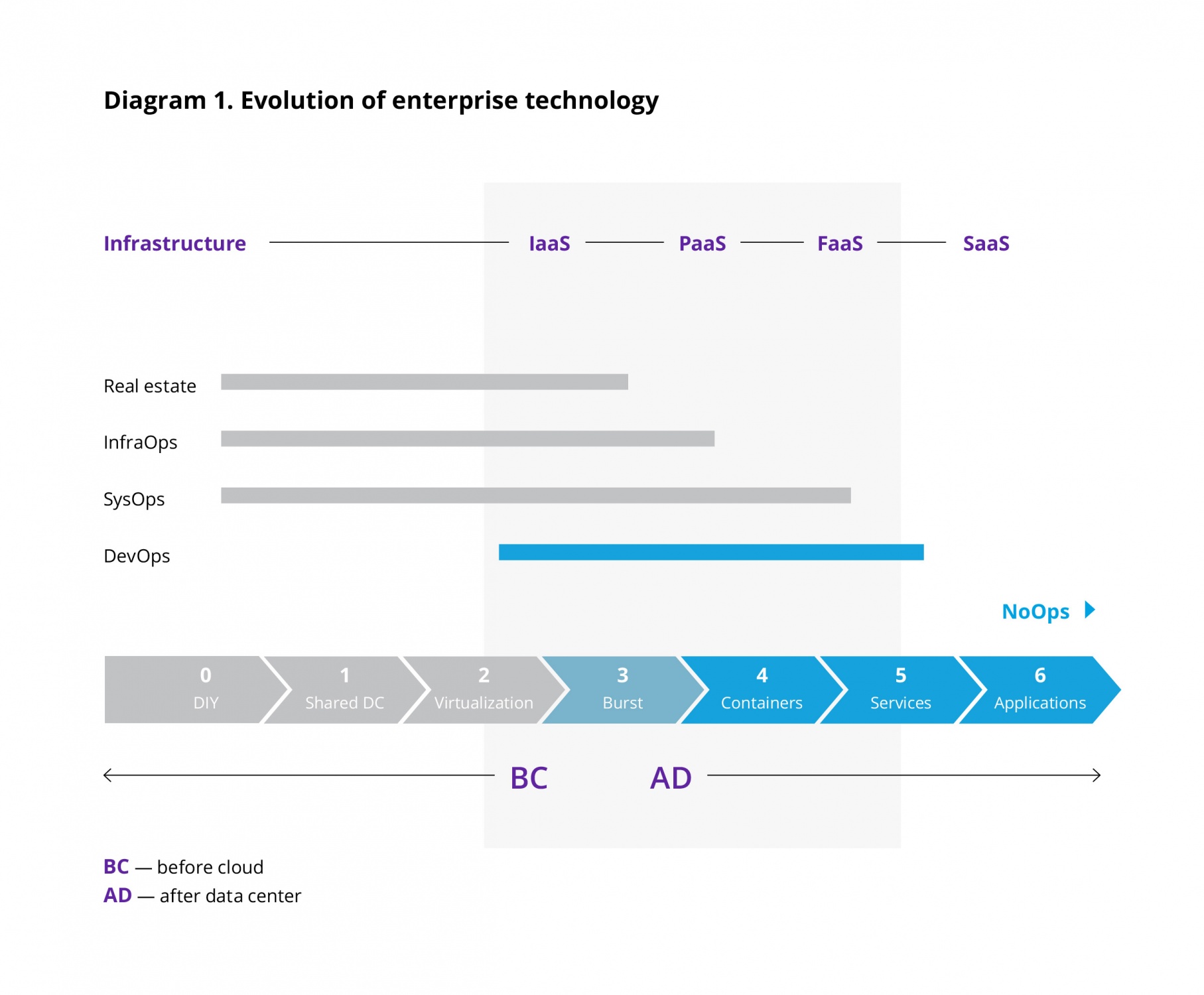In brief
- The evolution of infrastructure in the technology industry went through three phases: DIY data center, shared data center, and virtualization, each with its own challenges and limitations. Cloud adoption has brought benefits such as faster system deployment, improved disaster recovery, and increased infrastructure agility
- Cloud technology has progressed to offer Infrastructure as-a-Service (IaaS) and Platform as-a-Service (PaaS), enabling organizations to leverage virtualized compute and storage resources as well as managed infrastructure, databases, and messaging systems
- The future of cloud platform services includes serverless and Functions as-a-Service (FaaS) offerings, as well as the integration of business services and the rise of Software as-a-Service (SaaS) applications
Introduction and executive summary
This article explores the evolution of enterprise technology through seven stages. It highlights the impact on system development in capital markets and why organizations must adopt cloud-, modern- and service-orientated architecture.

Infrastructure BC
Before cloud (BC), there were three phases of infrastructure: DIY, shared data center (DC) and virtualization. Understanding these phases and how they were progressed by institutions’ technology infrastructure departments helps us appreciate the origins, and some of the benefits, of cloud technology.
0. DIY data center and in-house platform services
The data center was situated on business premises with an array of staff to look after it,
ranging from building services (security, building maintenance, utilities, racks), through
server administrators and network engineers, to database administrators.
Rolling out a
new system meant commissioning new, dedicated hardware. Ordering and installing could easily
have a lead time of 3 months and, if there were any constraints such as data center space
(during a DC migration perhaps) or a skill shortage, the lag time could hit 12
months.
The response of the bank’s technology division to new market opportunities and
regulatory requirements was very slow (typically planned in quarters and years). Also, disaster
recovery (DR) was often behind production, infrequently tested and only just capable of keeping
the lights on. No one could be confident that DR would work. Annual drills didn’t really prove
much.
1. Shared data center
Sharing data centers meant organizations could forget about the overheads of managing DC
premises, while benefiting from space flexibility and a cost-sharing model. Most
organizations would now have moved to several live data centers — sharing their regional or
system load. DR could be addressed more readily. Infrastructure management was incentivized
to adopt this model and own the migration.
However, there was still a heavy reliance
on physical hardware and, in banking and capital markets, a strong desire to isolate systems
to run on their own boxes. Hence, a reluctance to introduce new systems as that still meant
new hardware. This often led to unwieldy system extensions and compromised architecture (the
legacy of which can still be seen today).
It was common to see EOD reporting,
analytical services, computational services and transactions all mixed in the same systems,
which stemmed from a lack of infrastructure agility. It was also common to see data
replicated everywhere, so departments could limit dependency on infrequent releases and
manage their own change.
Administrators would build a cottage industry around
protecting production — seemingly designed to prevent any change at all — so securing
sign-off for new releases could also take months. This meant limiting the frequency of
change, bundling new features for testing and release and, subsequently, very simple but
big-impact changes could be delayed.
2. Virtualization
As systems ran on their own dedicated hardware, this meant that:
- Each system would have limited spare capacity for peak demand and future requirements
- Much of the infrastructure would be idle
Scalability issues were hard to address cost effectively.
Virtualization was the next
step, separating virtual servers from physical hardware. This enabled multiple virtual servers
to run independently on the same physical server, as if they were on their own box. Again driven
by infrastructure departments, primarily, to optimize hardware use and lower operational cost,
but it had another benefit. Virtual servers could be spun-up in minutes for new environments and
ventures.
IaaS (Infrastructure as-a-Service)

3. Dev, test and burst in the cloud
Constraints on the provision of environments in on-prem data centers can really slow down model
and systems development, testing and releases. Cloud could provide virtual networked compute and
storage over the internet. It proved popular for development, testing and burst, and was often
initiated by business users (citizen developers) and radical dev teams — especially in risk
systems where there are inherent spikes in compute demand across production, test and
development environments. The early adoption of cloud in these spaces advanced the DevOps
agenda. It enabled developers to undertake tasks traditionally managed by infrastructure
operations, ushering in Infrastructure as Code (IaC) with tools such as
Terraform.
Initially, cloud adoption for production deployment in capital markets was
slow, but now it’s accelerating at pace. Many senior decision-makers used to feel that cloud
just wasn’t right for their organization and the slow uptake was compounded by infrastructure
protectionism, misguided security and regulatory concerns, and no clear sponsorship and
ownership of the agenda. Divisions between infrastructure and development, as well as run the
bank and change the bank, meant the transformation agenda and its benefits were not aligned with
departmental objectives, so organizations were not set for cloud transformation. This
procrastination and stalled progress lasted almost a decade while change slowly precipitated
from the banks’ grass roots.
As we move into cloud-based virtual infrastructure,
distinctions between engineers and administrators are disappearing. Organizations need different
types of IT teams and help with the transformation.
Moving to cloud infrastructure
services is straightforward from a technology perspective. After all, the hyperscalers want your
business and will go the extra mile to make a lift-and-shift as easy as possible. If an
organization is immature with IaC and deployment, there will be an opportunity to progress this,
but the biggest challenges are in integrating new business processes into the organization. All
hyperscalers provide a cloud adoption framework (CAF) to guide an organization on its journey to
cloud.
With it being so easy to spin-up new infrastructure in the cloud, it’s equally
easy to accumulate, and lose track of, spiralling costs. To control and optimize costs, an
organization should have good cloud governance and an efficient FinOps model that allocates
costs, and balances self-policing with organizational oversight. The FinOps agenda will form an
important part of any CAF, and it makes sense to leverage the experience of a hyperscaler’s
partner on how to set this up correctly.
Cloud might eventually see the end of the
in-house data center and, while we’re not at that point yet, we’re already moving into the after
data center (AD) era; beyond simple virtual compute, networks and storage, to Platform
as-a-Service.
PaaS (Platform as-a-Service)
A second major selling point of cloud is its platform services. These comprise managed infrastructure, databases, messaging systems and the like. As organizations move into these managed cloud platform services, the distinctions between system administrators and developers starts to blur if not disappear altogether. In some ways, we’re going full circle and returning to the DIY days of old. The next generation of developers are expected to know these platform services, and microservices (container, API and mesh technologies). The DevOps agenda features tasks that were traditionally managed by system operations.
4. Containers and cloud deployment
Containers build on server virtualization. They isolate an application environment but utilize a shared operating system to enable more efficient use of the underlying hardware and much faster spin-up. Containers are set up using technology like Docker and Kubernetes can be used to manage container deployment and scalability. The efficiency and solid predictability of containers (for production, test and development environments) means organizations and developers naturally gravitate to the technology (the days of “but it worked in test” are gone). Across the whole of the capital markets technology space, institutions are now developing in containers — usually as part of a DevOps agenda — and actively moving legacy applications into a container stack. The payoff is such that most organizations want to get this done quickly and need additional developer bandwidth to do so. Cloud adoption accelerates the container agenda as, together, they’re a perfect fit.
5. Cloud platform services
Open-source software (OSS)
There‘s a strong relationship between cloud services and OSS, probably because:
- Hyperscalers want to make it easy to use their services, and OSS can offer standards, familiarity and portability
- Given OSS solutions already exist, it’s a fast way to expand service offerings
While there might be altruistic reasons too, the relationship between cloud and OSS is
self-reinforcing. As one becomes more popular, so does the other. Capital markets technology cannot
escape this and while there are widespread benefits of adopting OSS across the technology stack, in
the platform space, OSS has been a forced adoption. This has changed the perception of OSS. So, OSS
is set to move up the stack from platform to widespread application services, all available in the
cloud.
The availability of these services will drive players toward an API, event-driven and
serverless architecture. Currently, the perceived performance of cloud services is holding back
progress in the low-latency, front-office space. But in the middle and back office, we’re likely to
see rapid evolution. IPaaS (Integration Platform as-a-Service) has emerged to tie business workflows
together in this space.
Serverless and FaaS
Whether running or not, containers still need virtual infrastructure. The next evolution in cloud
platform services will be of those that only charge for runtime, being completely divorced from any
user knowledge of the virtual hardware on which they’re running (now tagged “serverless”). Functions
as-a-Service (FaaS) is still a relatively new paradigm for the capital markets space, as technology
requirements are generally quite heavy and these services are still focused on lightweight
requirements. However, they lend themselves to event management and process integration, and are
likely to be used for such things as customer onboarding, relationship management, trade lifecycle
and other process-driven requirements.
Further, serverless functions are evolving into mini
lightweight app environments.
Platform services
Platform services are core services that a developer would typically integrate into an application; services like databases and messaging. In the cloud, platform services don’t require operational assistance, however, popular OSS implementations will be available as well as hyperscaler proprietary solutions.

The choice can be overwhelming at first but, generally, there’s an obvious fit for each organization. Cloud architects can socialize the right stack.
Business services
Common business services such as email, are widely used in the cloud already. This will go much
further.
As applications are built around services and APIs, the opportunity to integrate
third-party business services becomes obvious and straightforward. If a third party offers the same
functionality for a cheaper cost that’s easily measurable or has features an organization needs,
simply integrate it through an easy OSS API swap-out or hook.
The need to utilize services
across hyperscalers and optimize costs will emerge. To date, most banks have partnered with a single
hyperscaler, but this will change and organizations will need to embrace a multi-cloud operational
environment, and a whole new set of governance standards and tooling.
SaaS (Software as-a-Service)
6. Applications
Perhaps the journey ends at SaaS. Here, an organization can devolve the entire application stack
either to a third party in a hyperscaler marketplace to run a standard service, or for a third party
to manage and advance a customized solution in the cloud.
ADAPTIX has been leading the way
through the whole journey, from the early days of distributed grid computing to burst to cloud, in
DevOps and cloud-first bespoke builds. We are now perfectly positioned to provide a fully managed
SaaS across capital markets (plus banking and insurance). In capital markets this includes:
- Client Lifecycle Management as-a-Service
- Trading Systems as-a-Service (TSaaS)
- Treasury Systems as-a-Service
- Investment Systems as-a-Service
Cloud began life as a provider of infrastructure compute and storage. It evolved to embrace platform, development and data services, and is now capable of delivering a fully managed solution for business services.









